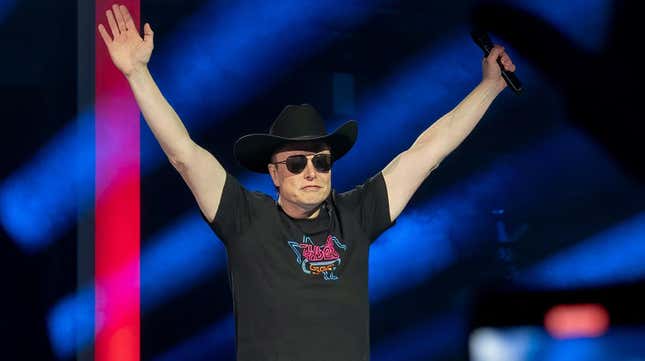
Apparently Tesla’s very busy. So busy, the electric vehicle maker can’t be bothered with things like international border crossings. It looks like Tesla now has its very own lane at the U.S.-Mexico border. The company-exclusive thoroughfare was first reported on by Bloomberg News, and confirmed by a representative from the Mexican Corporation for the Development of the Border Zone of Nuevo León in a phone call with Gizmodo.
A sign emblazoned with Tesla’s logo in all-caps now sits above one of the multiple lanes on the Mexico side of the Colombia Solidarity Border Crossing, which spans the Rio Grande between the Mexican state of Nuevo León and Webb County, Texas. The lane is intended to allow Tesla Inc. suppliers to cross the border more quickly, and avoid waits, Ivan Rivas, Nuevo León’s economic minister, told Bloomberg.
“It was a simple incentive,” Rivas said to Bloomberg. “What we want is a crossing that’s much more expedited and efficient. And maybe there will be a lane for other companies in the future like there is for Tesla.” Rivas, and multiple other Mexican officials did not immediately respond to Gizmodo’s request for comment. Tesla also did not immediately respond to our request for comment.
However, Gizmodo was able to get in touch with U.S. Customs and Border Patrol. A CBP press officer for southern Texas, Rick Pauza, seemed initially unaware of the new Tesla lane over the phone. Pauza indicated he hadn’t heard of the change, though mentioned that the Defend Trade Secrets Act might prevent him from discussing any details about it, if he had any.
In a follow-up email, Pauza said the following:
CBP would not be able to speak on behalf of the Government of Mexico or anything on the Mexico side of the Colombia-Solidarity International Bridge.
I checked with Laredo U.S. Customs and Border Protection trade operations management, and aside from the Free and Secure Trade (FAST) program and the dedicated lane for FAST participants, and the normal northbound cargo lanes, that is all that is available for northbound commercial trucks.
He further clarified that there is no dedicated Tesla lane for passenger vehicles on the U.S. northbound side of the border. So, at the very least, only the Mexico side of the border crossing seems to be offering Tesla special treatment.
At least six Tesla suppliers are located in Nuevo León, an increase up from zero prior to 2021, Rivas told Bloomberg. But, it is unclear if the lane is only for suppliers. An image of the crossing published by Bloomberg shows a (non-Tesla) passenger SUV going through the Tesla lane. So, is the dedicated crossing also for Tesla employees? What about people simply driving Tesla cars? What sort of verification does one present to pass through the lane? All also unclear.
The Colombia Solidarity Bridge border crossing is in a rural area about a 20 mile drive northwest of the much busier World Trade Bridge crossing in Laredo, Texas. At highest-traffic times on the U.S. managed side of the crossing, the standard wait for commercial vehicles at the Colombia Bridge is 22 minutes, according to CBP data. For vehicles in the FAST program, those average wait time drops to just 8 minutes. There is, as of yet, no data on average wait times for the Tesla lane.
In 2021, Tesla “technoking” Elon Musk relocated the company’s headquarters from Palo Alto, California to Austin, Texas. Though the Texas Tesla factory is seemingly not doing very well, Musk has persevered in the new location. He recently went so far as to apply for permits to build an underground, private transportation tunnel beneath the facility.
As a fun bonus: the richest man on Earth recently bragged on Twitter than his cars are “the most-made-in-USA vehicles.”